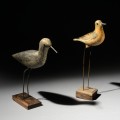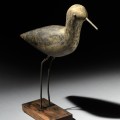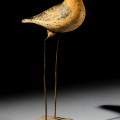Yellowlegs shorebird decoy
Robin snipe shorebird decoy
Two Shorebird Decoys
The hunting of shorebirds was a popular pastime during the second half of the 1800s in both Canada and the United States. This resulted in a devastating decline in the populations of several species; by the early 1900s, new regulations were introduced that greatly restricted this practice. Both of these carved shorebirds came from bird hunting gear used on the Toronto waterfront during the 1800s. The yellowlegs decoy, with the wire beak, belonged to William Humphrey, whose parents operated the Highland Creek Inn.


